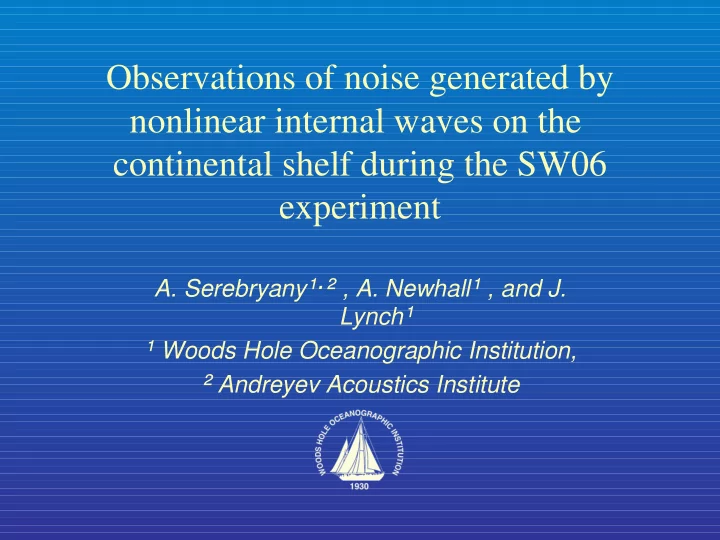

Observations of noise generated by nonlinear internal waves on the continental shelf during the SW06 experiment ∙ , A. Newhall ¹ , and J. A. Serebryany ¹ ² Lynch ¹ ¹ Woods Hole Oceanographic Institution, ² Andreyev Acoustics Institute
Motivation Paper of Serebryany, Furduev et al.”Noise of large-amplitude internal wave in the ocean” published in Doklady, 2005. It was shown that passing of the 50-m solitary internal wave in the Indian Ocean lead to significant increase (up to 18 dB) of underwater noise level at frequency in a range of 5-15 kHz. Noise level record (a) and spectral noise levels (b) at moments marked by1-4
SW06 experiment area
Objective • To study the effect of internal wave as source of ambient noise generation on the basis of SW06 data
SHARK and other mooring positions of SW06
SHARK configuration VLA consists of 16 hydrophones (at depth 13 m – 77.5 m) HLA – 32 hydrophones on a bottom (at a distance 3 m - 468 m from VLA)
HLA orientation
Train of intense internal waves observed on August, 19, as it seen from temperature contours. It is clear manifested nonlinear character of the waves in their depression forms
Internal wave characteristics: depression waves on a sharp subsurface thermocline; tidal periodicity of internal wave train occurrence; direction of propagation ~ 300 N; heights: 10-15 m, up to 25 m; period: 5-9 min; length: several hundred meters; speed: ~ 1 m/s; and strong orbital currents
• Observation of sea-bed noise induced by internal waves
Spectrogram for the leading six waves of internal wave train, August, 19 (top) and isotherm displacements for the same time interval (dawn)
Temperature oscillations at four horizons during passing of internal wave train, August, 19. Clear seen evidences of breaking internal waves beginning from the third wave.
Spectrogram for the leading six waves of internal wave train, August, 19 (top) and temperature oscillations at horizon 15 m and 22.5 m for the same time interval (dawn)
Spectrogram and isotherms for the leading wave of the train, August, 19 and for 2-nd and 3-rd wave. non-breaking wave breaking wave
Set of spectrograms from hydrophones of HLA demonstrating a process of propagation of spikes in time 45 • 31 44 19 • 43 18 • 42 17 • 38 16 • 37
Estimation of speed of the event propagation 45 37 19 18 16
Velocity magnitude for internal wave train on August, 19 (ADCP data). Bottom current for the leading internal waves achieves as much as 0.5 m/s and more
East velocity component for internal wave train on August, 19 (ADCP data) achieves as much as 0.5 m/s.
Vertical velocity for internal wave train on August, 19 (ADCP data) achieves as much as 0.20 m/s and more.
Sea-surface noise induced by internal wave
ERS satellite image (15:36 23 July 2006) with depth contours and mooring positions. The image is an evidence of strong interaction of the internal waves with the sea surface.
Spectra calculated from records of hydrophone in subsurface layer (13 m) for moment before appearance of depression wave, case “S” (up) and for moment of front face passing of depression wave, case “R” (down)
Sketch, demonstrating the effect of internal depression wave on the sea surface and bottom leading to underwater sound generation Interaction with sea surface 1. Internal wave due to it’s orbital currents creates zone of convergence in the upper layer. 2. The zone of convergence effects on the sea surface creating rip band ahead of internal wave trough. 3. The rip band consists of breaking surface waves (white caps). Breaking waves are recognized as a significant and well known source of ambient underwater noise in the ocean 4. Generation of bubbles by air entrainment, splitting of bubbles, evolving bubbles into flow of orbital currents (deepening) Interaction with sea bed 1. Strong internal wave orbital currents in the bottom layer can remove sand and small stones. (The process is similar to noise generation in surf zone)
Conclusions Two main sources of underwater noise connected with internal • wave propagation on a shelf were revealed; More significant one is a process of the sea-bed interaction with • orbital currents of intense internal waves; strong orbital currents in bottom layer can remove horizontal • chain of hydrophones creating spikes on spectrograms of hydrophone records (due to bottom friction); The second process is connected with generation of rip bands • (or choppy waves) on the sea surface by internal wave. The process in this case is not so significant to compare with the sea-bed noise generation and generation of underwater noise by large-amplitude internal waves in the deep ocean, but increasing of noise level up to 5 dB was revealed.
Recommend
More recommend